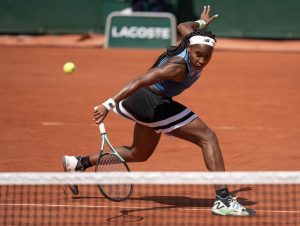As has become customary in recent years, Martin Keady, our resident tennis historian, looks back at 2020, beginning with the unfortunate and regrettable events of the year.
- COVID
There are absolutely no prizes for guessing what is No.1 on this list. Indeed, it might have been easier simply to write a list of “Ten Terrible Things Covid Did To Tennis In 2020”, such was its all-encompassing effect on tennis throughout the year, as indeed on every other aspect of 21st-century life. From the cancellation of Indian Wells at the end of March, there was virtually no professional tennis at all, on either the ATP or the WTA Tours, for the next three months, and even when the events themselves resumed there were virtually no fans to watch them. Almost all of the North American events leading up to the US Open, and the US Open itself, had no fans at all. And even when the rearranged European clay court season, including the French Open, was played in the autumn, at best only a smattering of fans were allowed to watch in socially distanced conditions.
Tennis fares better than most sports on TV, because a tennis court naturally fills the entirety of a TV screen, which makes it easier to conceal the absence of spectators. Nevertheless, tennis, like every other sport and virtually every other form of live performance (musical, theatrical etc.), has discovered this year that the absence of fans at an event reduces it almost immeasurably. Quite simply, the fans cannot come back fast enough, for tennis and every other sport.
- NOVAK DJOKOVIC’S ADRIA TOUR
There were numerous knock-on effects from Covid, some of which are included on this list, but one of the most damaging for tennis was the Adria (short for Adriatic) Tour organised by Novak Djokovic, to try and provide some top-level competition for players during the initial lockdown/quarantine period in the spring. There were similar events throughout the tennis world, and a notable success was “The Battle of the Brits”, in which Britain’s best male players, including Andy Murray, competed against each other in a Covid-secure environment at Britain’s National Tennis Centre in Roehampton, near London.
However, the Adria Tour was almost the polar opposite of that ultra-controlled environment, with players not only appearing before reasonably large crowds but then partying hard afterwards at local nightclubs. Needless to say, several of them, including Grigor Dimitrov, contracted Covid, and Dimitrov himself complained later in the year that he had actually suffered long covid (the more enduring form of the disease). That only compounded the initial folly of staging the Adria Tour with such lax controls for both players and fans.
- NO WIMBLEDON
Previously, only the two World Wars had stopped Wimbledon from going ahead; even the 1919 Spanish Flu epidemic failed to prevent play on the greenest, lushest lawns in London. But the 2020 Covid pandemic, despite being far less deadly than the Spanish Flu epidemic a century before, eventually led to the cancellation of the world’s oldest and greatest tennis tournament this year.
In part, this was a testament to the All England Club’s forward planning, as they were seemingly the only major institution or event in the world to have “pandemic insurance”, meaning that they could cancel the 2020 version and be reimbursed by their insurers, rather than having to go ahead without any fans being present, as was the case at the US Open, or with only a few fans present, as was the case at the French Open. Nevertheless, Wimbledon’s cancellation and the subsequent cancellation of all the grass-court events in Europe left a massive hole in the tennis calendar, especially for lovers of the original and arguably still the best form of the game.
- THE AUSTRALIAN BUSHFIRES AFFECTING QUALIFYING AT THE AUSTRALIAN OPEN
Such has been the devastating impact of Covid on tennis and everything else that it is easy to forget what had initially appeared to be the environmental disaster story of the year, namely the Australian bush fires at the start of 2020. Their effect on tennis in Australia at the start of the year was negligible when compared with their effect on the Australian environment, including its unique flora and fauna. Nevertheless, they still threw the start of the tennis year into confusion, with doubts being expressed that the 2020 Australian Open would take place at all. Eventually it did, but only after numerous qualifiers, including Britain’s Liam Broady, had complained loudly and volubly about the unfairness – indeed, the danger – of their being forced to play in the appalling environmental conditions, including dreadful air quality, that the bushfires caused.
- THE ALLEGATIONS OF DOMESTIC ABUSE AGAINST ALEXANDER ZVEREV
As was widely said in the aftermath of the domestic abuse allegations against Alexander Zverev by his pregnant ex-girlfriend, Olga Sharypova, the US Open organisers must have been mightily relieved that Dominic Thiem, rather than Zverev, won the US Open. Otherwise, the media spotlight on the young German player would have been even more intense than it already was.
It must be emphasised that Zverev has completely denied the allegations and that Sharypova has not yet translated them into any legal action. Nevertheless, it was certainly not a “good look” for tennis for one of its best young players even to be accused of such a heinous crimes, especially in a year when domestic abuse rates around the world have risen dramatically while couples of all kinds have been forced to lock down together.
Beyond the Zverev-Sharypova case itself, the allegations brought into focus the fact that the ATP has no official policy on the condemnation and official punishment (in sporting terms at least) of domestic abuse, unlike other sports such as basketball. Andy Murray, for one, said loudly and publicly that that was a glaring error that needed rectifying immediately. Zverev isn’t the only ATP player who was accused of domestic violence, Nikoloz Basilashvili the current #40 in the world rankings (career high of #16) was charged in May with assaulting his ex-wife in front of their child, the case is still working its way through the courts.
- THE FRENCH OPEN MEN’S SINGLES FINAL
The next four items on this list are all related to the final Major of the year, the French Open, which, because of the pandemic, was played out in October rather than in May/June. The rearrangement itself was controversial, as the organisers of the French Open made it and announced it unilaterally, without consulting any of the other Majors (including the US Open, which of course is traditionally the final Major of the year) or the ATP and WTA.
However, the biggest disappointment of all at the French Open when it finally took place was the Men’s Singles Final, between Rafael Nadal and Novak Djokovic. At the end of a generally dreadful year for tennis in particular and sport in general, it was genuinely hoped and perhaps even anticipated that it would be a classic, as both men went into it in such fine form, with Nadal defending his title and Djokovic the reigning World No.1. Instead, it was the dampest of squibs, with Nadal exacting a kind of revenge for his own thrashing by Djokovic in the 2019 Australian Open Final. Nadal bageled (or, perhaps more accurately, “claygelled”) Djokovic in the first set and only lost seven games in total in the next two sets as he eventually and easily triumphed 6-0, 6-2, 7-5. It was, of course, his 13th French Open title in total, and the unluckiest of them all for any fans hoping to see, after his years of domination in Paris, a truly competitive final.
- ANDY MURRAY’S FIRST ROUND DEFEAT AT THE FRENCH OPEN
Can Andy Murray ever really come back – i.e. to the top of the men’s game, where for so long he was the “Fourth Man” to “The Gigantic Three” of Federer, Nadal and Djokovic? Increasingly, the suspicion is that he cannot. Certainly, anyone who witnessed his almost complete annihilation by Stan Wawrinka in the first round of the French Open in October would have thought that it was almost impossible for the Great Scot to return to his former glory as a three-time Major winner and double Olympic Champion. Less than a year earlier, Murray had actually raised hopes that he might make a triumphant comeback when he defeated the same opponent (Wawrinka) in the European Open Final in Antwerp. But such was the severity of his defeat at Roland Garros in the autumn of 2020 that any chance of his ever competing for another Major or even Olympic title must be considered remote at best.
- THE LINE-CALLING AT THE FRENCH OPEN
Hawkeye (or equivalent electronic systems) has become such a staple of tennis over the last decade or so that its continuing absence from most clay court events, and especially from the French Open, is now glaring. In fact, it is an oversight that surely must be rectified in time for the next French Open, which will hopefully take place in the spring of 2021. At this year’s French Open, there were numerous examples of questionable or even downright bad line calls that cost players greatly, nobody more so than Denis Shapovalov in his match against Spain’s Roberto Carballés Baena, when he was the subject of a dreadful call at the conclusion of the match, which he never recovered from and eventually led to his defeat in five sets.
The sight of players and umpires arguing over which particular mark in the clay was the correct one is increasingly ludicrous in the 21st century. The French Open must emulate every other Major and even some other clay court events (such as the one in Rio) and at least start experimenting with Hawkeye as soon as possible.
- THE EFFECTIVE ENDING OF THE WTA TOUR IN OCTOBER
The danger of putting all your eggs in one basket was dramatically demonstrated by the WTA this autumn. The huge amount invested by China in WTA events over the last few years has effectively meant that the conclusion of the WTA season is almost exclusively played out in China, culminating in the end-of-season event for the best eight women players in the world. Unfortunately, because of Covid and the continuing quarantine restrictions in China in particular, all of those events were cancelled this year, which meant a premature end to the WTA Tour after the French Open.
The fact that the Women’s Singles title in Paris had just been won so stunningly by Iga Swiatek, who looks like she could just be the next dominant World No.1 in the women’s game, only exacerbated the sense of loss. In the future, the WTA should learn from the experience of 2020 and ensure that it does not concentrate so many events, especially at the conclusion of the season, in any one geographical area.
- DARIA KASATKINA’S INABILITY TO DEVELOP A DECENT SERVE
And finally, a personal gripe, or at least a gripe shared by all lovers of artistic and imaginative tennis. As I wrote two years ago in the 2018 version of this piece, Russia’s Daria Kasatkina has every shot in tennis except the most important one – the serve. The fact that two years on she still has not been able to improve her serve significantly, or even sufficiently, is a damning indictment of both her and her coaching staff. At her best, she is the antidote to so many other women who are just power-players pure and simple, as she plays, particularly on clay, with rare verve and flair, improvising and even inventing shots almost endlessly. But until she can master that one shot, which of course is the most important shot in tennis, the sport will be denied ever seeing her challenging at its top echelons.
Next week: 10 Terrific Things In Tennis In 2020.
Main Photo:






